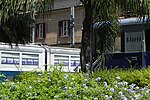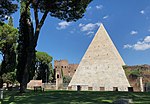Piramide (Rome Metro)
1955 establishments in ItalyRailway stations in Italy opened in the 1950sRailway stations opened in 1955Rome Metro Line B stationsRome Q. X Ostiense

Piramide is a station on Line B of the Rome Metro. It was opened on 10 February 1955 and is sited on Piazzale Ostiense (across which is the Pyramid of Cestius that gives the station its name) just outside Porta San Paolo, in the Ostiense quarter. Its atrium houses mosaics that have won the Artemetro Roma by Enrico Castellani (Italy) and Beverly Pepper (United States). The station has escalators.
Excerpt from the Wikipedia article Piramide (Rome Metro) (License: CC BY-SA 3.0, Authors, Images).Piramide (Rome Metro)
Piazzale Ostiense, Rome Municipio Roma I
Geographical coordinates (GPS) Address Nearby Places Show on map
Geographical coordinates (GPS)
| Latitude | Longitude |
|---|---|
| N 41.875555555556 ° | E 12.482222222222 ° |
Address
+ricicli +viaggi (Piramide)
Piazzale Ostiense
00154 Rome, Municipio Roma I
Lazio, Italy
Open on Google Maps











